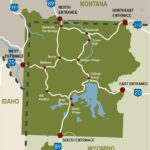Route 66, the “Main Street of America,” is more than just a highway; it’s a symbol of American freedom, adventure, and the open road. Spanning over 2,400 miles, this legendary route beckons travelers from across the globe to experience the heart and soul of the United States. But before embarking on this iconic journey, one crucial question arises: Where Does Route 66 Start? Let’s delve into the origins of this celebrated highway and discover the starting point of an unforgettable American adventure.
You might have heard about driving the entirety of the original Route 66, from its beginning to end. However, time and progress have led to sections being replaced or even lost. Far from diminishing its allure, this discontinuity adds to the unique charm of a Route 66 road trip. Navigating detours and alternative paths becomes part of the adventure, leading you through quaint towns and picturesque landscapes that are often missed on modern highways. The journey itself, with its unexpected turns and discoveries, becomes as enriching as the destinations.
Adding to the magic are the numerous historic roadside attractions and landmarks that have stood the test of time along Route 66. These enduring icons are integral to the Route 66 experience, offering tangible links to the past. Whether you are a history enthusiast or simply seeking an extraordinary travel experience, tracing Route 66 is a journey that promises lasting memories.
The Historical Genesis of Route 66
Often lovingly called the “Mother Road,” a moniker bestowed by John Steinbeck in his poignant 1939 novel, “The Grapes of Wrath,” Route 66 holds a distinguished place as one of the foundational highways within the U.S. Highway System. Its construction in 1926 marked a pivotal moment in American history, designed to knit together the eastern and western expanses of a rapidly growing nation, facilitating westward expansion and exploration.
As the decades progressed, the landscape of American highways underwent significant transformation. The late 1950s witnessed the rise of the Federal Highway System, introducing newer, more direct interstate routes. This development, while enhancing travel efficiency, inadvertently led to the bypassing of numerous smaller communities and attractions that thrived along Route 66. Consequently, traffic dwindled on the Mother Road, and by the 1970s, its prominence as a primary artery of transportation had waned.
The year 1985 marked the official decommissioning of Route 66 from the Federal Highway System. The burgeoning Interstate Highway System had effectively superseded it. Yet, the spirit of Route 66 was far from extinguished. Preservationists rallied to safeguard its legacy, and the National Park Service stepped in, designating significant segments of the highway as National Scenic Byways and historic districts. This crucial recognition ensures that the historical and cultural significance of Route 66 will be cherished and preserved for generations to come.
Where Does Historic Route 66 Officially Commence?
Chicago, Illinois: The Eastern Terminus Unveiled
For those eager to trace the origins of this iconic highway, the answer to “where does Route 66 start” lies in the bustling metropolis of Chicago, Illinois. Specifically, the official eastern starting point of Route 66 is situated in the heart of downtown Chicago, at the intersection of Adams Street and Michigan Avenue. This landmark location is clearly marked, inviting travelers to begin their Mother Road journey with a sense of historical significance. A commemorative plaque and a sign proudly declare, “Historic Route 66 Begins Here,” serving as a symbolic gateway to the adventures that lie ahead.
 Historic Route 66 Begin Sign in Downtown Chicago
Historic Route 66 Begin Sign in Downtown Chicago
Exploring the Starting Point: Chicago’s Adams Street and Michigan Avenue
Standing at the corner of Adams Street and Michigan Avenue, you’re not just at the genesis of Route 66; you’re immersed in the vibrant energy of downtown Chicago. Take a moment to soak in the atmosphere before you embark on your cross-country journey. This intersection is easily accessible and makes for a perfect photo opportunity to commemorate the start of your historic road trip.
While you’re in the area, consider exploring some of Chicago’s renowned attractions. Millennium Park, home to the iconic Cloud Gate sculpture (often called “The Bean”), is just a short walk away. The Art Institute of Chicago, a world-class museum, is also nearby for art enthusiasts. Before hitting the road, grabbing a classic Chicago-style hot dog can be a delicious way to begin your culinary journey along Route 66.
Tracing Westward: States and Attractions Along the Mother Road
While the central focus is on “where does Route 66 start,” understanding the vast expanse and the diverse landscapes it traverses adds depth to the journey. From Chicago, Route 66 winds its way westward through eight states, each offering its unique slice of Americana.
Illinois: Beyond Chicago, Illinois is steeped in Route 66 history. Springfield, the state capital, is home to the Abraham Lincoln Presidential Library and Museum, a must-visit for history buffs. Cozy Dog Drive-In in Springfield and Ariston Cafe in Litchfield are classic diners that offer a taste of authentic Route 66 cuisine.
Missouri: The iconic Gateway Arch in St. Louis is a towering symbol of westward expansion and a highlight of Route 66 in Missouri. Meramec Caverns in Stanton offers underground wonders, and the Chain of Rocks Bridge in Madison County presents a unique architectural marvel with its mid-river bend.
Kansas: While Kansas boasts the shortest stretch of Route 66, it’s rich in nostalgia. Galena’s Main Street and the “Cars on the Route” museum, featuring the truck that inspired Tow Mater from the movie “Cars,” are delightful stops. Baxter Springs is home to the Rainbow Bridge, believed to be the oldest concrete bridge on Route 66.
Oklahoma: Oklahoma City offers a compelling blend of modern city life and Wild West history. The Oklahoma City National Memorial & Museum provides a poignant experience, while Stockyards City transports visitors back to the city’s cattle drive era. The Route 66 Museum in Clinton is a treasure trove of Mother Road memorabilia.
Texas: The quirky Cadillac Ranch in Amarillo is an unmissable art installation where visitors are encouraged to spray paint classic Cadillacs buried nose-first in the ground. McLean’s Devil’s Rope Museum offers a fascinating, if unusual, look at the history of barbed wire.
New Mexico: New Mexico’s landscapes and cultural heritage are captivating. Taos Pueblo, a UNESCO World Heritage site, showcases ancient Native American dwellings. Santa Rosa’s Blue Hole is a stunning natural swimming spot, and Tucumcari is known for its vibrant Route 66 murals and the historic Blue Swallow Motel.
Arizona: Arizona is home to some of the most breathtaking natural wonders along Route 66, including the Grand Canyon, Petrified Forest National Park, and the Painted Desert. Oatman, a historic mining town with roaming donkeys, and the Wigwam Motel in Holbrook offer unique roadside experiences. Williams, Arizona, serves as a gateway to the Grand Canyon and boasts a charming Route 66 downtown.
California: The final state on the westward journey, California, presents diverse landscapes from the Mojave Desert to the Pacific coast. The Santa Monica Pier marks the traditional western terminus of Route 66. California also offers attractions like the Calico Ghost Town, the Route 66 Mother Road Museum in Barstow, and numerous classic motels and diners.
The Western End: Reaching the Pacific at Santa Monica
While we’ve focused on “where does Route 66 start,” it’s natural to wonder about its conclusion. Originally, in 1926, Route 66 ended in downtown Los Angeles. However, in 1936, the route was extended to Santa Monica, California, officially terminating at the intersection of Olympic Boulevard and Lincoln Boulevard. Today, the Santa Monica Pier is often considered the symbolic and more picturesque end of the road for many Route 66 travelers, offering a celebratory finish line with the Pacific Ocean as a backdrop.
Planning Your Route 66 Adventure from the Starting Point
Embarking on a Route 66 road trip, beginning from its official starting point in Chicago, requires some planning to ensure a smooth and enriching experience.
Best Time to Travel: Spring and fall generally offer the most comfortable weather for a Route 66 road trip. Spring brings wildflowers and mild temperatures, while fall boasts stunning foliage, particularly in the eastern states. Summer can be hot, especially in the desert regions, but it’s also peak season with numerous events. Winter can bring snow and cold, especially in the Midwest, which might affect travel conditions.
Transportation: Driving your own car or renting a vehicle is the most popular way to experience Route 66, allowing for flexibility and the freedom to explore at your own pace. Motorcycles offer an adventurous open-air experience. Guided tours are also available for those who prefer a structured itinerary and narrated experiences.
Route Planning Tips:
- Research and Itinerary: Before you set off from the Route 66 start in Chicago, research attractions and towns along your desired route. Plan a flexible itinerary, allowing for spontaneous stops and detours.
- Accommodation: Book accommodations in advance, especially during peak season, particularly in popular Route 66 towns.
- Vehicle Check: Ensure your vehicle is road-trip ready. Consider a vehicle suitable for varying terrains and potential weather conditions.
- Budget: Factor in costs for gas, food, accommodation, and attractions.
- Flexibility: Embrace the unexpected. Route 66 is about the journey, so be open to detours and unplanned stops.
- Pack Smart: Pack for varying weather conditions, comfortable driving clothes, and essentials for roadside stops.
Conclusion: Begin Your Mother Road Journey
Understanding “where does Route 66 start” is the first step in embarking on an extraordinary American adventure. From its humble beginnings in downtown Chicago, Route 66 unfolds a tapestry of history, culture, and breathtaking landscapes across the United States. Whether you plan to traverse the entire route from start to finish or explore a select segment, the Mother Road promises an unforgettable journey filled with nostalgia, discovery, and the enduring spirit of the open road. So, start your engines in Chicago, and let the iconic Route 66 guide you on an American odyssey.
FAQ
Where Does Route 66 Start and End?
Route 66 officially starts at the intersection of Adams Street and Michigan Avenue in Chicago, Illinois, and traditionally ends at the intersection of Olympic Boulevard and Lincoln Boulevard in Santa Monica, California. Symbolically, many consider the Santa Monica Pier as the end point.
What States Does Route 66 Cross?
Route 66 passes through eight states: Illinois, Missouri, Kansas, Oklahoma, Texas, New Mexico, Arizona, and California.
How Long is Route 66?
The approximate length of Route 66 is 2,448 miles (3,940 kilometers).
How Long Does It Take to Drive Route 66?
Driving the entirety of Route 66 typically takes around two to three weeks, depending on your pace, stops, and detours. Some may do it in less time by focusing on driving, while others may take longer to fully immerse themselves in the attractions and experiences along the way.
Are Guided Tours of Route 66 Available?
Yes, numerous guided and escorted tours of Route 66 are available. These tours offer various levels of service, from basic transportation and accommodation packages to comprehensive, narrated journeys with planned itineraries and attractions. Guided tours can be a great option for those who prefer a structured experience and want to learn in-depth about the history and culture of Route 66.

